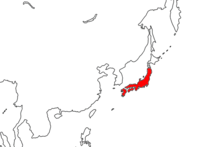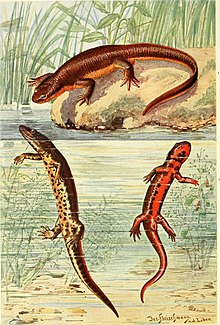Japanese fire-bellied newt
| Japanese fire-bellied newt Temporal range: Middle Miocene – Present
| |
|---|---|

| |
| Female Japanese fire-bellied newt | |
| Scientific classification | |
| Domain: | Eukaryota |
| Kingdom: | Animalia |
| Phylum: | Chordata |
| Class: | Amphibia |
| Order: | Urodela |
| Family: | Salamandridae |
| Genus: | Cynops
|
| Species: | C. pyrrhogaster
|
| Binomial name | |
| Cynops pyrrhogaster (Boie, 1826)
| |

| |
| Synonyms[2] | |
|
Molge pyrrhogaster (Boie, 1826) | |
The Japanese fire-bellied newt or Japanese fire-bellied salamander (Cynops pyrrhogaster) is a species of
The species is found on many
The Japanese fire-bellied newt first diverged from its closest relative in the
Etymology and taxonomy
The species was first
The Integrated Taxonomic Information System lists sixteen synonyms for Cynops pyrrhogaster.[9] Common names of the species include Japanese fire-bellied newt,[1] red-bellied newt,[10] and Japanese fire-bellied salamander.[11] Studies examining morphological and geographic variation had formerly recognized six races: Tohoku, Kanto, Atsumi, intermediate, Sasayama, and Hiroshima,[12] one of which, the Sasayama, was described as a subspecies in 1969 by Robert Mertens as Triturus pyrrhogaster sasayamae, which is now considered a synonym of C. pyrrhogaster.[2] Modern molecular analysis supports the division of C. pyrrhogaster into four clades instead.[12] In particular, the validity of the Sasayama and intermediate races has never been proven, with one study finding no behavioral differences between the two supposed forms.[13]

|
Cynops pyrrhogaster diverged from its close relative
Description

On the newt's upper body, the skin is dark brown, approaching black, and covered in wartlike bumps. The underbelly and the underside of its tail are bright red, with black spots.
The vomeropalatine teeth, a group of teeth in the upper back of the mouth, are arranged in two series. The tongue is relatively small, half the width of the mouth. The nostrils are positioned anteriorly (toward the head), closer to each other than to the eyes and hardly visible when viewed from above. The toes of males are longer than those of females, although the females themselves are longer. The tail is tightly compressed, with fins on both the top and bottom. A smooth ridge runs from their nape to their tail.[19] The full body length of adults is 8 to 15 cm (3.1 to 5.9 in).[11] Snout–vent length can be anywhere between 43.0 and 64.0 mm (1.69 and 2.52 in) for males and 48.5 and 75.0 mm (1.91 and 2.95 in) for females. Populations from more northern and elevated regions tend to be larger than those in southern and lower-altitude regions.[20] Eggs are 2.1 to 2.3 mm (0.083 to 0.091 in) long.[17]
Distribution and habitat
Cynops pyrrhogaster is
Of the four clades, the northern is found in the districts of Tohoku and Kanto. This does not overlap with the range of the central clade, which is found in Chubu, northern Kansai, and eastern Chugoku. The central's range has a small amount of overlap with the western, which is found in southern Kinki, western Chugoku, Shikoku, and central Kyushu. The western also has some overlap with the southern clade, which is found in western and southern Kyushu.[12]
The newts occur at elevations of 30 to 2,020 m (98 to 6,627 ft). Ecosystems they are found in include forests, grasslands, shrublands, wetlands, lakes, marshes, and cultivated environments. They can also dwell in humanmade bodies of water, such as aquaculture ponds.[1]
Behavior and ecology

Reproduction and life cycle
Breeding occurs in paddy fields, ponds, brooks, pools, and streams. Females accept male courtship behavior from spring to early summer.[20] Males and females both produce peptide pheromones to attract the opposite sex when ready to mate. Males produce a type known as sodefrin (from the Japanese term sodefuri, lit. 'soliciting');[22] females have their own variety, named imorin by its discoverers (from the Japanese term imo, lit. 'beloved woman', and rin from sodefrin). These are released from the cloaca, and were the first peptide pheromone to be identified in a vertebrate and first to be identified in a female vertebrate, respectively.[10][23]
Courtship begins when the male approaches the female, sniffing its sides or cloaca. The male then brings its tail to the female and rapidly vibrates it. The female responds by pushing the male's neck with its snout. At this point, the male slowly moves away, undulating its tail, and the female follows, touching the tail with its snout when close enough. The male then deposits two to four spermatophores, one at a time, moving several centimeters after each, which the female attempts to pick up with its cloaca, sometimes unsuccessfully.[24] Females lay eggs separately on underwater objects, such as leaves and submerged grass roots, fertilized one by one from the spermatophores they carry. They can lay up to 40 eggs in one session, and 100 to 400 eggs in a breeding season.[24]

The young hatch from their eggs after about three weeks, as swimming, gilled larvae, with dorsal tailfins. They grow around 3 cm (1.2 in) in the first three months of their lives. At between five and six months, they stop eating and undergo metamorphosis, losing their gills and fins, and becoming juveniles. Juveniles cannot remain submerged in water like larvae or they drown.[25][26] Newts at lower altitudes mature faster than those at higher ones. Male newts of higher-altitude populations tend to live longer after reaching maturity, but their fully grown size is not as large as that of lowland newts. Wild individuals as old as twenty-three have been found.[20]
Spermatogenesis
Cynops pyrrhogaster is regarded as an ideal vertebrate model for investigating the mechanism(s) involved in the transition from mitosis to meiosis during spermatogenesis.[27] In males, this transition involves expression of PCNA, a DNA polymerase delta auxiliary protein employed in DNA replication and DNA repair.[27] Also involved in the transition is DMC1, a protein employed in genetic recombination.[27]
Diet
In captive settings
Predators

Newts in
Against snakes, newts from Fukue Island tend to perform tail-wagging displays, designed to bring a predator's attention to their replaceable tail rather than their more vital head; those from
Toxin
Wild Japanese fire-bellied newts contain high levels of the neurotoxin tetrodotoxin (TTX).[30] This toxin inhibits the activity of sodium channels in most vertebrates, discouraging predation by both birds and mammals.[29] Experiments have shown the toxin is almost entirely derived from the newt's diet. When raised in captivity with no source of TTX, 36- to 70-week-old juveniles did not contain detectable levels, but wild specimens from the same original habitat had high toxicity. In younger captive-reared newts some TTX was still detected, which was inferred to have been transferred by adult females to their eggs.[30] In a follow-up experiment by the same team, captive-reared newts were given food containing the neurotoxin. They readily consumed TTX-laced bloodworms when offered, not showing any symptoms after ingesting the poison. It was detectable in their bodies afterward, further indicating food to be the source of the toxin. No TTX-producing organisms are known from their habitat, but their existence is likely, and would explain the origin of TTX in wild newts.[31]
Conservation
The
Japanese fire-bellied newts with mysterious
A variety, believed to be found exclusively on the
Interactions with humans
Research
Japanese fire-bellied newts serve as a highly useful model organism in laboratory settings, but they become more difficult to care for after metamorphosis. An experiment supported by the Japan Society for the Promotion of Science found that thiourea (TU) can prevent this process from occurring, allowing the animals to stay in their pre-metamorphosis form for as long as two years, while still capable of metamorphosizing when removed from the TU solution. This did not have any impact on their regeneration capabilities.[25]
Japanese fire-bellied newts produce motilin, a peptide that stimulates gastrointestinal contractions, identified in many vertebrates. It is created in the upper small intestine and pancreas. The discovery of the latter was the first time pancreatic motilin had been observed. The organ also produces insulin. These results represented the first discovery of motilin in amphibians, suggesting that it has a similar role for them as it does for birds and mammals. The existence of pancreatic motilin also indicated another, unknown function.[35]
This species, as well as other
In captivity
Cynops pyrrhogaster can be kept in captivity.
Notes
References
- ^ . Retrieved 12 November 2021.
- ^ from the original on 2 May 2021. Retrieved 8 January 2023.
- ^ Oken, Lorenz (1826). "Isis von Oken". Expedition der Isis (in German): 203–204. Archived from the original on 10 January 2023. Retrieved 8 January 2023.
- ^ from the original on 28 October 2022. Retrieved 28 October 2022.
- ISBN 978-1-4081-3326-2. Retrieved 13 November 2022.
- from the original on 28 October 2022. Retrieved 28 October 2022.
- from the original on 28 October 2022. Retrieved 28 October 2022.
- from the original on 28 October 2022. Retrieved 28 October 2022.
- ^ "Cynops pyrrhogaster". itis.gov. Archived from the original on 30 October 2022. Retrieved 30 October 2022.
- ^ PMID 28120945.
- ^ a b c "Cynops pyrrhogaster". usgs.gov. Archived from the original on 28 October 2022. Retrieved 27 October 2022.
- ^ PMID 23103571. Retrieved 28 October 2022.
- from the original on 30 October 2022. Retrieved 30 October 2022.
- from the original on 29 October 2022. Retrieved 29 October 2022.
- ^ from the original on 18 November 2022. Retrieved 29 October 2022.
- ^ from the original on 29 October 2022. Retrieved 29 October 2022.
- ^ from the original on 30 October 2022. Retrieved 30 October 2022.
- from the original on 30 October 2018. Retrieved 30 October 2022.
- from the original on 30 October 2022. Retrieved 30 October 2022.
- ^ from the original on 29 October 2022. Retrieved 29 October 2022.
- from the original on 30 October 2022. Retrieved 30 October 2022.
- PMID 26935790.
- from the original on 29 October 2022. Retrieved 29 October 2022.
- ^ from the original on 30 October 2022. Retrieved 30 October 2022.
- ^ S2CID 22637590. Retrieved 30 October 2022.
- from the original on 18 November 2022. Retrieved 30 October 2022.
- ^ a b c Yazawa T, Yamamoto T, Nakayama Y, Hamada S, Abé S. Conversion from mitosis to meiosis: morphology and expression of proliferating cell nuclear antigen (PCNA) and Dmc1 during newt spermatogenesis. Dev Growth Differ. 2000 Dec;42(6):603-11. doi: 10.1046/j.1440-169x.2000.00544.x. PMID 11142682
- from the original on 31 October 2022. Retrieved 31 October 2022.(subscription required)
- ^ PMID 34843491.
- ^ PMID 25986913. Retrieved 27 October 2022.
- PMID 28734983. Retrieved 28 October 2022.
- ^ "Japanese fire-bellied newt". iucnredlist.org. Archived from the original on 26 January 2021. Retrieved 30 October 2022.
- from the original on 29 October 2022. Retrieved 29 October 2022.
- from the original on 30 October 2022. Retrieved 30 October 2022.
- from the original on 29 October 2022. Retrieved 29 October 2022.
- ^ PMID 27499865.
- from the original on 30 October 2022. Retrieved 30 October 2022.
- from the original on 30 October 2022. Retrieved 30 October 2022.
- ^ McLeod, Lianne. "Fire Belly Newt: Species Profile". thesprucepets.com. Archived from the original on 30 October 2022. Retrieved 30 October 2022.

